If you’re like me, you have a diverse caseload of kids that learn the social-emotional skills we want to teach them in different ways. We counselors can’t seem to get enough of finding new and creative ways to engage our kids in therapy. After countless hours planning and prepping, I’ve found a couple simple truths for my work:
- Preparation is MORE than half the battle.
- Teaching in therapy has to be exciting.
- Great things happen in groups.
- Art supplies are your friend.
I’m sure I’m not saying anything new, but often I think it can be a task within a task to make great therapy happen. In lots of trial and error, I’ve discovered a secret weapon, therapeutic art activities. Unfortunately, I was always intimidated by the thought of facilitating these activities because my artistic ability was non-existent.
Research suggests there is a direct correlation between the creative arts and health outcomes when used in a therapeutic setting. Experience suggests AMAZING healing can happen with children when you combine a caring helping professional and some art supplies.
If your school is anything like the norm, there is a huge focus on group counseling because of its outcomes for children. Crossing art and group counseling can be a jackpot for school counselors.
Therapeutic art activities in group counseling can be useful working with children struggling with:
- Trauma
- Anxiety
- Depression
- Suicidal Ideations
- Impulse control/ ADHD
- Social skills deficits
- Self esteem
- AND MORE
So what’s next? How do we tackle art therapy sans the artists? Here’s the key. It’s all about creation, an end product that requires some reflection and conversation to get there. Below are some key steps to take to have a great counseling group using art.
Counsel two birds with one stone
Select children with similar issues and create a group. This builds empathy, a circle of support, and strengths for the members of the group. This also helps you plan activities more efficiently.
Prepare
This is the part that’s going to take some creativity and planning. There are many resources available to help you with this. Hubforhelpers, Pinterest, and Teachers Pay Teachers can be amazing resources to help you get started with your art activities. Be sure your activities require coloring, cutting, gluing, or painting. This excites students and prompts them to open up!
Break the Ice
It’s important we start our therapy groups with a fun way to get to know group members. We never want to intimidate members with asking for too much from them too soon. I like to start with simple icebreakers. Kids are always ready to go after setting the stage with one of these activities and they require little prep from the counselor.
First, Go Low
Unfortunately, there is a stigma attached to counseling and it doesn’t take children long to figure that out. One of the goals of counseling should be to engage children in sessions so that they actually enjoy the therapeutic process.

A part of this is eliminating the risk of that very first session. Your first group should involve more art than counseling. Give kids a chance to get comfortable getting to know each other and beginning to use pictures and colors in therapy. Try either a Get to Know Me Banner or the Power of Color Activity

Be a Member and a Facilitator
Whatever activity you’ve planned for your kids, join them! I like doing this because it shows your group members that the drawing does not have to be perfect. It’s also notable that members feel more comfortable when everyone is seen as equals in the group.
Be a facilitator as well, once kids pick up art supplies, have your discussions ready! Discussion questions should always be relevant to the activity. It’s also helpful after some time to let others come up with discussion questions after previewing the activity.
Differentiate
That may sound a little teacher-ish, but a part of providing equity to our kids is giving all children the opportunity to create something great in art therapy. It’s helpful to bring along stickers, cutouts, a print out of some symbols, and for the group to brainstorm what they can draw. This allows your kiddos that are not so comfortable drawing an opportunity to create.
Share, Praise, and Post
By the time you’ve completed an activity, you have a couple of great options. Wrap up questions allow members to reflect on one or two things they learned or thought were important. Allow members to share their creations and receive praise and positive feedback from other members. If it’s an activity the group created together, POST IT! Kids feel proud when they see something they created on display for others to see.
Takeaways
Combine group counseling with drawing, painting or creating. Don’t over think it!
Requires planning
It is moving from discussing emotions to creating something that represents emotions.
So Beneficial
All research suggests it’s effective for the treatment of a range of presenting problems.
Use in Groups or Individual Counseling
Groups are always great because kiddos can practice social skills and experience group success and approval from members but art activities can be used in your one on one sessions as well.
Engages Students
A well thought out therapeutic art activity will excite children about working through some tough topics, it will also foster a student’s opportunity to achieve success. This is extremely helpful for our kiddos that receive little academic success.
It’s a Coping Skill
In and of itself, creation is a coping skill. Children that struggle with anxiety, trauma or depression will feel more relaxed after your session.
What therapeutic art activities do you use in counseling? How has it helped your students?
Check out the Confident Counselors Series of counseling activities using art and office supplies you already have in your office!








I enjoyed reading your article and your enthusiasm for using art therapeutically! As a music therapist (MT-BC), I understand Art Therapist’s need for clinical boundaries and want to offer a suggestion to use terms other than art therapy, such as therapeutic art, when referring to the use of art in counseling. Although art is a great tool that can be utilized by clinicians, art therapy is provided by art therapists who completed their masters level degree in counseling and art therapy. I am of course far less versed in art therapy than music therapy, but feel free to check out https://arttherapy.org/ if you’d like to learn more! Again, thank you for the great article and I appreciate the opportunity to offer my thoughts to a fellow clinician 🙂
Thank you so much for your thoughtful, constructive comment Stephanie. I went through and made the adjustments to the wording. Completely agree that that differentiation and language is important. If you ever want to write a post about music therapy, we’d love to have you. 🙂